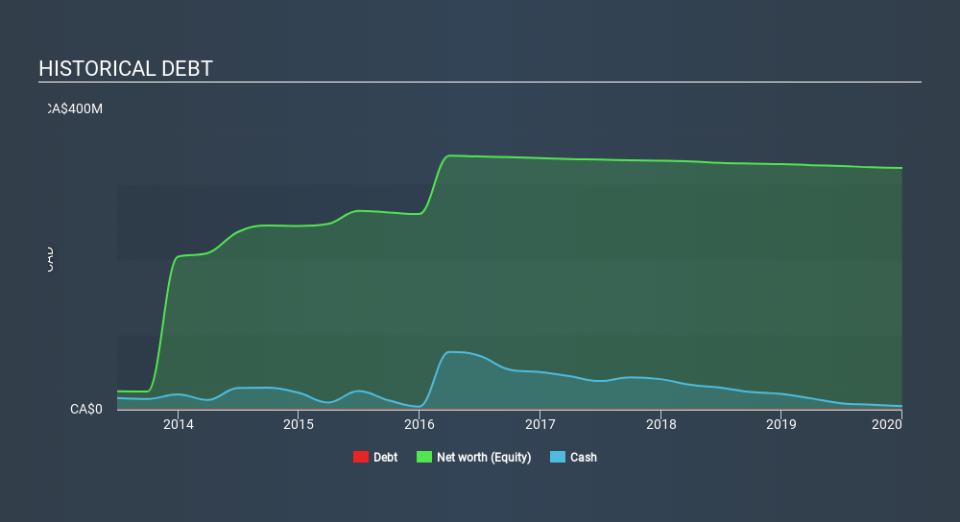Can Fission Uranium (TSE:FCU) Afford To Invest In Growth?

We can readily understand why investors are attracted to unprofitable companies. For example, although Amazon.com made losses for many years after listing, if you had bought and held the shares since 1999, you would have made a fortune. But the harsh reality is that very many loss making companies burn through all their cash and go bankrupt.
So, the natural question for Fission Uranium (TSE:FCU) shareholders is whether they should be concerned by its rate of cash burn. For the purposes of this article, cash burn is the annual rate at which an unprofitable company spends cash to fund its growth; its negative free cash flow. Let's start with an examination of the business's cash, relative to its cash burn.
Check out our latest analysis for Fission Uranium
When Might Fission Uranium Run Out Of Money?
You can calculate a company's cash runway by dividing the amount of cash it has by the rate at which it is spending that cash. In December 2019, Fission Uranium had CA$4.8m in cash, and was debt-free. Importantly, its cash burn was CA$16m over the trailing twelve months. So it had a cash runway of approximately 4 months from December 2019. That's a very short cash runway which indicates an imminent need to douse the cash burn or find more funding. You can see how its cash balance has changed over time in the image below.
How Is Fission Uranium's Cash Burn Changing Over Time?
Fission Uranium didn't record any revenue over the last year, indicating that it's an early stage company still developing its business. So while we can't look to sales to understand growth, we can look at how the cash burn is changing to understand how expenditure is trending over time. As it happens, the company's cash burn reduced by 17% over the last year, which suggests that management may be mindful of the risks of their depleting cash reserves. Clearly, however, the crucial factor is whether the company will grow its business going forward. So you might want to take a peek at how much the company is expected to grow in the next few years.
How Hard Would It Be For Fission Uranium To Raise More Cash For Growth?
Even though it has reduced its cash burn recently, shareholders should still consider how easy it would be for Fission Uranium to raise more cash in the future. Issuing new shares, or taking on debt, are the most common ways for a listed company to raise more money for its business. One of the main advantages held by publicly listed companies is that they can sell shares to investors to raise cash to fund growth. We can compare a company's cash burn to its market capitalisation to get a sense for how many new shares a company would have to issue to fund one year's operations.
Fission Uranium's cash burn of CA$16m is about 21% of its CA$78m market capitalisation. That's not insignificant, and if the company had to sell enough shares to fund another year's growth at the current share price, you'd likely witness fairly costly dilution.
So, Should We Worry About Fission Uranium's Cash Burn?
On this analysis of Fission Uranium's cash burn, we think its cash burn reduction was reassuring, while its cash runway has us a bit worried. After considering the data discussed in this article, we don't have a lot of confidence that its cash burn rate is prudent, as it seems like it might need more cash soon. Taking a deeper dive, we've spotted 4 warning signs for Fission Uranium you should be aware of, and 1 of them makes us a bit uncomfortable.
Of course Fission Uranium may not be the best stock to buy. So you may wish to see this free collection of companies boasting high return on equity, or this list of stocks that insiders are buying.
If you spot an error that warrants correction, please contact the editor at editorial-team@simplywallst.com. This article by Simply Wall St is general in nature. It does not constitute a recommendation to buy or sell any stock, and does not take account of your objectives, or your financial situation. Simply Wall St has no position in the stocks mentioned.
We aim to bring you long-term focused research analysis driven by fundamental data. Note that our analysis may not factor in the latest price-sensitive company announcements or qualitative material. Thank you for reading.

 Yahoo Finance
Yahoo Finance 
